Runlin Lei
Future Link Prediction Without Memory or Aggregation
May 26, 2025Abstract:Future link prediction on temporal graphs is a fundamental task with wide applicability in real-world dynamic systems. These scenarios often involve both recurring (seen) and novel (unseen) interactions, requiring models to generalize effectively across both types of edges. However, existing methods typically rely on complex memory and aggregation modules, yet struggle to handle unseen edges. In this paper, we revisit the architecture of existing temporal graph models and identify two essential but overlooked modeling requirements for future link prediction: representing nodes with unique identifiers and performing target-aware matching between source and destination nodes. To this end, we propose Cross-Attention based Future Link Predictor on Temporal Graphs (CRAFT), a simple yet effective architecture that discards memory and aggregation modules and instead builds on two components: learnable node embeddings and cross-attention between the destination and the source's recent interactions. This design provides strong expressive power and enables target-aware modeling of the compatibility between candidate destinations and the source's interaction patterns. Extensive experiments on diverse datasets demonstrate that CRAFT consistently achieves superior performance with high efficiency, making it well-suited for large-scale real-world applications.
Dynamic and Textual Graph Generation Via Large-Scale LLM-based Agent Simulation
Oct 13, 2024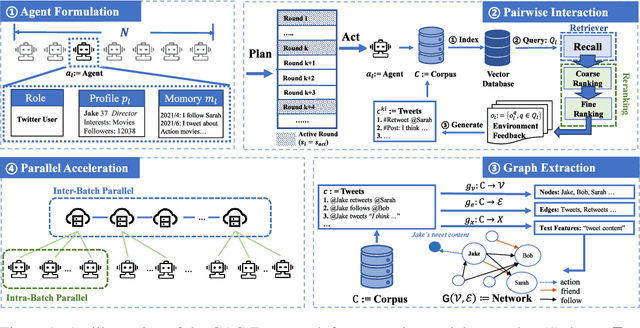

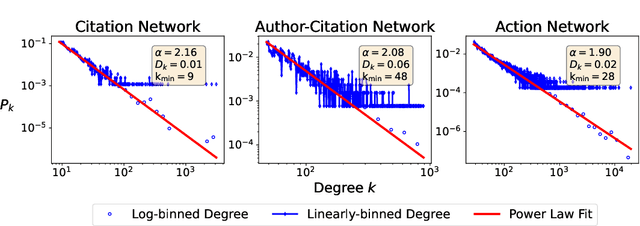

Abstract:Graph generation is a fundamental task that has been extensively studied in social, technological, and scientific analysis. For modeling the dynamic graph evolution process, traditional rule-based methods struggle to capture community structures within graphs, while deep learning methods only focus on fitting training graphs. This limits existing graph generators to producing graphs that adhere to predefined rules or closely resemble training datasets, achieving poor performance in dynamic graph generation. Given that graphs are abstract representations arising from pairwise interactions in human activities, a realistic simulation of human-wise interaction could provide deeper insights into the graph evolution mechanism. With the increasing recognition of large language models (LLMs) in simulating human behavior, we introduce GraphAgent-Generator (GAG), a novel simulation-based framework for dynamic graph generation. Without training or fine-tuning process of LLM, our framework effectively replicates seven macro-level structural characteristics in established network science theories while surpassing existing baselines in graph expansion tasks by 31\% on specific evaluation metrics. Through node classification task, we validate GAG effectively preserves characteristics of real-world network for node-wise textual features in generated text-rich graph. Furthermore, by incorporating parallel acceleration, GAG supports generating graphs with up to nearly 100,000 nodes or 10 million edges through large-scale LLM-based agent simulation, with a minimum speed-up of 90.4\%. The source code is available at https://anonymous.4open.science/r/GraphAgent-2206.
Scalable and Accurate Graph Reasoning with LLM-based Multi-Agents
Oct 07, 2024



Abstract:Recent research has explored the use of Large Language Models (LLMs) for tackling complex graph reasoning tasks. However, due to the intricacies of graph structures and the inherent limitations of LLMs in handling long text, current approaches often fail to deliver satisfactory accuracy, even on small-scale graphs and simple tasks. To address these challenges, we introduce GraphAgent-Reasoner, a fine-tuning-free framework that utilizes a multi-agent collaboration strategy for explicit and precise graph reasoning. Inspired by distributed graph computation theory, our framework decomposes graph problems into smaller, node-centric tasks that are distributed among multiple agents. The agents collaborate to solve the overall problem, significantly reducing the amount of information and complexity handled by a single LLM, thus enhancing the accuracy of graph reasoning. By simply increasing the number of agents, GraphAgent-Reasoner can efficiently scale to accommodate larger graphs with over 1,000 nodes. Evaluated on the GraphInstruct dataset, our framework demonstrates near-perfect accuracy on polynomial-time graph reasoning tasks, significantly outperforming the best available models, both closed-source and fine-tuned open-source variants. Our framework also demonstrates the capability to handle real-world graph reasoning applications such as webpage importance analysis.
Beyond Over-smoothing: Uncovering the Trainability Challenges in Deep Graph Neural Networks
Aug 07, 2024

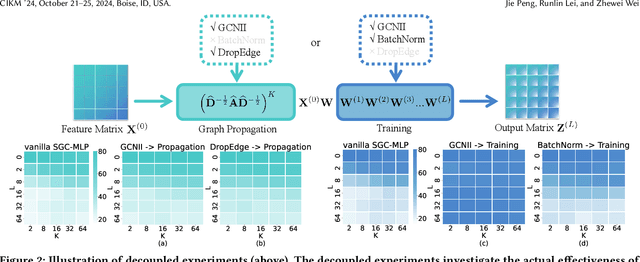

Abstract:The drastic performance degradation of Graph Neural Networks (GNNs) as the depth of the graph propagation layers exceeds 8-10 is widely attributed to a phenomenon of Over-smoothing. Although recent research suggests that Over-smoothing may not be the dominant reason for such a performance degradation, they have not provided rigorous analysis from a theoretical view, which warrants further investigation. In this paper, we systematically analyze the real dominant problem in deep GNNs and identify the issues that these GNNs towards addressing Over-smoothing essentially work on via empirical experiments and theoretical gradient analysis. We theoretically prove that the difficult training problem of deep MLPs is actually the main challenge, and various existing methods that supposedly tackle Over-smoothing actually improve the trainability of MLPs, which is the main reason for their performance gains. Our further investigation into trainability issues reveals that properly constrained smaller upper bounds of gradient flow notably enhance the trainability of GNNs. Experimental results on diverse datasets demonstrate consistency between our theoretical findings and empirical evidence. Our analysis provides new insights in constructing deep graph models.
Intruding with Words: Towards Understanding Graph Injection Attacks at the Text Level
May 26, 2024Abstract:Graph Neural Networks (GNNs) excel across various applications but remain vulnerable to adversarial attacks, particularly Graph Injection Attacks (GIAs), which inject malicious nodes into the original graph and pose realistic threats. Text-attributed graphs (TAGs), where nodes are associated with textual features, are crucial due to their prevalence in real-world applications and are commonly used to evaluate these vulnerabilities. However, existing research only focuses on embedding-level GIAs, which inject node embeddings rather than actual textual content, limiting their applicability and simplifying detection. In this paper, we pioneer the exploration of GIAs at the text level, presenting three novel attack designs that inject textual content into the graph. Through theoretical and empirical analysis, we demonstrate that text interpretability, a factor previously overlooked at the embedding level, plays a crucial role in attack strength. Among the designs we investigate, the Word-frequency-based Text-level GIA (WTGIA) is particularly notable for its balance between performance and interpretability. Despite the success of WTGIA, we discover that defenders can easily enhance their defenses with customized text embedding methods or large language model (LLM)--based predictors. These insights underscore the necessity for further research into the potential and practical significance of text-level GIAs.
EvenNet: Ignoring Odd-Hop Neighbors Improves Robustness of Graph Neural Networks
May 27, 2022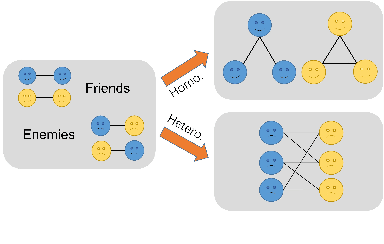


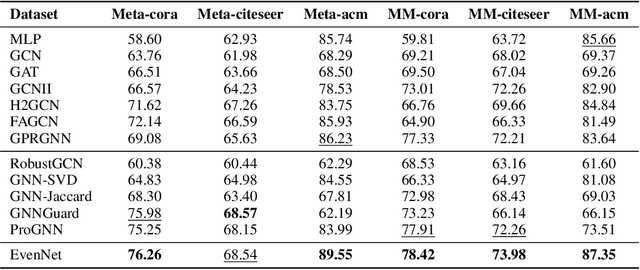
Abstract:Graph Neural Networks (GNNs) have received extensive research attention for their promising performance in graph machine learning. Despite their extraordinary predictive accuracy, existing approaches, such as GCN and GPRGNN, are not robust in the face of homophily changes on test graphs, rendering these models vulnerable to graph structural attacks and with limited capacity in generalizing to graphs of varied homophily levels. Although many methods have been proposed to improve the robustness of GNN models, most of these techniques are restricted to the spatial domain and employ complicated defense mechanisms, such as learning new graph structures or calculating edge attentions. In this paper, we study the problem of designing simple and robust GNN models in the spectral domain. We propose EvenNet, a spectral GNN corresponding to an even-polynomial graph filter. Based on our theoretical analysis in both spatial and spectral domains, we demonstrate that EvenNet outperforms full-order models in generalizing across homophilic and heterophilic graphs, implying that ignoring odd-hop neighbors improves the robustness of GNNs. We conduct experiments on both synthetic and real-world datasets to demonstrate the effectiveness of EvenNet. Notably, EvenNet outperforms existing defense models against structural attacks without introducing additional computational costs and maintains competitiveness in traditional node classification tasks on homophilic and heterophilic graphs.
 Add to Chrome
Add to Chrome Add to Firefox
Add to Firefox Add to Edge
Add to Edge